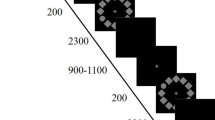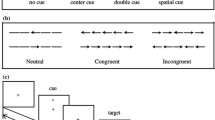Abstract
Sleep loss, widespread in today’s society and associated with a number of clinical conditions, has a detrimental effect on a variety of cognitive domains including attention. This study examined the sequelae of sleep deprivation upon BOLD fMRI activation during divided attention. Twelve healthy males completed two randomized sessions; one after 27 h of sleep deprivation and one after a normal night of sleep. During each session, BOLD fMRI was measured while subjects completed a cross-modal divided attention task (visual and auditory). After normal sleep, increased BOLD activation was observed bilaterally in the superior frontal gyrus and the inferior parietal lobe during divided attention performance. Subjects reported feeling significantly more sleepy in the sleep deprivation session, and there was a trend towards poorer divided attention task performance. Sleep deprivation led to a down regulation of activation in the left superior frontal gyrus, possibly reflecting an attenuation of top-down control mechanisms on the attentional system. These findings have implications for understanding the neural correlates of divided attention and the neurofunctional changes that occur in individuals who are sleep deprived.




Similar content being viewed by others
References
Akerstedt, T., & Folkard, S. (1996). Predicting duration of sleep from the three process model of regulation of alertness. Occupational and Environmental Medicine, 53(2), 136–141.
Anstey, K., Wood, J., Lord, S., & Walker, J. (2005). Cognitive, sensory and physical factors enabling driving safety in older adults. Clinical Psychology Review, 25, 45–65.
Basner, M., Fomberstein, K. M., Razavi, F. M., Banks, S., William, J. H., Rosa, R., et al. (2007). American time use survey: sleep time and its relationship to waking activities. Sleep, 30(9), 1085–1095.
Boivin, D. B. (2000). Influence of sleep-wake and circadian rhythm disturbances in psychiatric disorders. Journal of Psychiatry & Neuroscience, 25(5), 446–458.
Chee, M., & Chuah, L. (2007). Functional neuroimaging and behavioural correlates of capacity decline in visual short-term memory after sleep deprivation. Proceedings of the National Academy of Sciences, 104(22), 9487–9492.
Chee, M. W. L., Tan, J. C., Zheng, H., Parimal, S., Weissman, D. H., Zagorodnov, V., et al. (2008). Lapsing during sleep deprivation is associated with distributed changes in brain activation. The Journal of Neuroscience, 28(21), 5519–5528.
Choo, W.-C., Lee, W.-W., Venkatraman, V., Sheu, F.-S., & Chee, M. W. L. (2005). Dissociation of cortical regions modulated by both working memory load and sleep deprivation and by sleep deprivation alone. Neuroimage, 25, 579–587.
Corbetta, M., Miezin, F. M., Dobmeyer, S., Shulman, G. L., & Petersen, S. E. (1991). Selective and divided attention during visual discriminations of shape, color, and speed: functional anatomy by positron emission tomography. The Journal of Neuroscience, 11, 2383–2402.
Courtney, S. M., Petit, L., Maisog, J. M., Ungerleider, L. G., & Haxby, J. V. (1998). An area specialized for spatial working memory in human frontal cortex. Science, 279(5355), 1347–1351.
Doran, S. M., Van Dongen, H. P. A., & Dinges, D. F. (2001). Sustained attention performance during sleep deprivation: evidence of state instability. Archives Italiennes de Biologie, 139(3), 253–267.
Dorsey, C. M. (2000). Spectroscopy before and after total sleep deprivation in healthy adult men. Sleep, 23(Supp 2), A357–A358.
Dove, A., Manly, T., Epstein, R., & Owen, A. (2008). The engagement of mid-ventrolateral prefrontal cortex and posterior brain regions in intentional cognitive activity. Human Brain Mapping, 29(1), 107–119.
Drummond, S. P. A., Gillin, J. C., & Brown, G. G. (2001). Increased cerebral response during a divided attention task following sleep deprivation. Journal of Sleep Research, 10(2), 85–92.
Durmer, J. S., & Dinges, D. F. (2005). Neurocognitive consequences of sleep deprivation. Seminars in Neurology, 25(1), 117–129.
Friston, K. (2007). Statistical parametric mapping: the analysis of functional brain images, vol. 1. London: Academic Press, Incorporated.
Gulyas, B., & Roland, P. E. (1991). Cortical fields participating in form and colour discrimination in the human brain. NeuroReport, 2, 585–588.
Habeck, C., Rakitin, B. C., Moeller, J., Scarmeas, N., Zarahn, E., Brown, T., et al. (2004). An event-related fMRI study of the neurobehavioral impact of sleep deprivation on performance of a delayed-match-to-sample task. Cognitive Brain Research, 18, 306–321.
Harrison, Y., & Horne, J. (1999). One night of sleep loss impairs innovative thinking and flexible decision making. Organizational Behaviour and Human Decision Processes, 78(2), 128–145.
Jewett, M. E., Dijk, D. J., Kronauer, R. E., & Dinges, D. F. (1999). Dose-response relationship between sleep duration and human psychomotor vigilance and subjective alertness. Sleep, 22(2), 171–179.
Johns, M. W. (1991). A new method for measuring daytime sleepiness: the Epworth sleepiness scale. Sleep, 14(6), 540–545.
Johns, M. W. (1993). Daytime sleepiness, snoring, and obstructive sleep apnea. The Epworth Sleepiness Scale. Chest, 103(1), 30–36.
Johnson, J. A., & Zatorre, R. J. (2006). Neural substrates for dividing and focusing attention between simultaneous auditory and visual events. Neuroimage, 31(4), 1673–1681.
Johnson, J. A., Strafella, A., & Zatorre, R. J. (2007). The role of the dorsolateral prefrontal cortex in bimodal divided attention: two transcranial magnetic stimulation studies. Journal of Cognitive Neuroscience, 19(6), 907–920.
Kanwisher, N., & Wojciulik, E. (2000). Visual attention: insights from brain imaging. [Article]. Nature Reviews. Neuroscience, 1(2), 91–100.
Katz, D. A., & McHorney, C. A. (1998). Clinical correlates of insomnia in patients with chronic illness. Archives of Internal Medicine, 158(10), 1099–1107.
Lauderdale, D. S., Knutson, K. L., Yan, L. L., Rathouz, P. J., Hulley, S. B., Sidney, S., et al. (2006). Objectively measured sleep characteristics among early-middle-aged adults the CARDIA study. American Journal of Epidemiology, 164(1), 5–16.
Lim, J., & Dinges, D. F. (2008). Sleep deprivation and vigilant attention. Annals of the New York Academy of Sciences, 1129, 305–322.
Lim, J., Tan, J. C., Parimal, S., Dinges, D. F., & Chee, M. W. L. (2010). Sleep deprivation impairs object-selective attention: a view from the ventral visual cortex. PLoS ONE, 5(2), e9087.
Loose, R., Kaufmann, C., Auer, D. P., & Lange, K. (2003). Human prefrontal and sensory cortical activity during divided attention tasks. Human Brain Mapping, 18, 249–259.
Maislin, G., Pack, A. I., Kribbs, N. B., Smith, P. L., Schwartz, A. R., Kline, L. R., et al. (1995). A survey screen for prediction of apnea. Sleep, 18(3), 158–166.
McKnight, A. J., & McKnight, A. S. (1999). Multivariate analysis of age-related driver ability and performance deficits. Accident Analysis and Prevention, 31(5), 445–454.
McNair, D., Lorr, M., & Droppleman, L. (1992). EdITS manual for the profile of mood states. San Diago: EdITS.
Menefee, L. A., Cohen, M. J. M., Anderson, W. R., Doghramji, K., Frank, E. D., & Lee, H. (2000). Sleep disturbance and nonmalignant chronic pain: a comprehensive review of the literature. Pain Medicine, 1(2), 156–172.
Michie, P., Budd, T., Fulham, W. R., Hughes, M., Jamadar, S., Johnston, P., et al. (2008). The potential for new understandings of normal and abnormal cognition by integration of neuroimaging and behavioral data: not an exercise in carrying coals to newcastle. Brain Imaging & Behaviour, 2(4), 318–326.
Miyake, A., & Shah, P. (1999). Models of working memory: Mechanisms of active maintenance and executive control. New York: Cambridge University Press.
National Sleep Foundation, N. (2005). 2005 Sleep in America Polls: Summary of Findings. Washington DC: National Sleep Foundation.Available at: http://www.sleepfoundation.org/sites/default/files/2005_summary_of_findings.pdf.
National Transport Safety Board. (1995). Factors that affect fatigue in heavy truck accidents. Washington, DC: NTSB. No. PB95-917001. Available at: http://www.ntsb.gov/publictn/1995/SS9502.pdf.
Nieoullon, A. (2002). Dopamine and the regulation of cognition and attention. Progress in Neurobiology, 67(1), 53–83.
Nilsson, J. P., Söderström, M., Karlsson, A. U., Lekander, M., Åkerstedt, T., Lindroth, N. E., et al. (2005). Less effective executive functioning after one night’s sleep deprivation. Journal of Sleep Research, 14(1), 1–6.
Pilcher, J. J., & Huffcutt, A. I. (1996). Effects of sleep deprivation on performance: a meta-analysis. Sleep, 19(4), 318–326.
Rasser, P. E., Johnston, P., Lagopoulos, J., Ward, P. B., Schall, U., Thienel, R., et al. (2005). Functional MRI BOLD response to Tower of London performance of first-episode schizophrenia patients using cortical pattern matching. Neuroimage, 26(3), 941–951.
Rogers, N., & Kloss, J. (2005). Medical conditions and diseases. In C. Kushida (Ed.), Sleep deprivation. Clinical issues, pharmacology, and sleep loss effects (pp. 81–120). New York: Marcel Dekker.
Rosekind, M. R., Gregory, K. B., Mallis, M. M., Brandt, S. L., Seal, B., & Lerner, D. (2010). The cost of poor sleep: workplace productivity loss and associated costs. Journal of Occupational and Environmental Medicine, 52(1), 91–98.
Schall, U., Johnston, P., Lagopoulos, J., Jüptner, M., Jentzen, W., Thienel, R., et al. (2003). Functional brain maps of Tower of London performance: a positron emission tomography and functional magnetic resonance imaging study. Neuroimage, 20(2), 1154–1161.
Stuss, D. (2006). Frontal lobes and attention: processes and network fractionation and integration. Journal of the International Neuropsychological Society, 12, 261–271.
Thomas, M. L., Balkin, T., Sing, H., Wesensten, N., & Belenky, G. (1998). PET imaging studies of sleep deprivation and sleep: implications for behaviour and sleep function. Journal of Sleep Research, 7(Supp 2), 274.
Thomas, M., Sing, H., Belenky, G., Holcomb, H., Mayberg, H., Dannals, R., et al. (2000). Neural basis of alertness and cognitive performance impairments during sleepiness. I. Effects of 24 h of sleep deprivation on waking human regional brain activity. Journal of Sleep Research, 9(4), 335–352.
Tucker, A. M., Whitney, P., Belenky, G., Hinson, J. M., & Van Dongen, H. P. A. (2010). Effects of sleep deprivation on dissociated components of executive functioning. Sleep, 33(1), 47–57.
Van Dongen, H. P. A., Maislin, G., Mullington, J. M., & Dinges, D. F. (2003). The cumulative cost of additional wakefuleness: dose-response effects on neurobehavioual functions and sleep physiology from chronic sleep restriction and total sleep deprivation. Sleep, 26(2), 117–126.
Van Dongen, H., Baynard, M., Maislan, G., & Dinges, D. (2004). Systematic interindividual differences in neurobehavioral impairment from sleep loss: evidence of trait-like differential vulnerability. Sleep, 27(3), 423–433.
Wu, J. C., Gillin, J. C., Buchsbaum, M. S., Hershey, T., Hazlett, E., Sicotte, N., et al. (1991). The effect of sleep deprivation on cerebral glucose metabolic rate in normal humans assessed with positron emission tomography. Sleep, 14(2), 155–162.
Wu, J. C., Gillin, J. C., Buchsbaum, M. S., Chen, P., Keator, D. B., Khosla Wu, N., et al. (2006). Frontal lobe metabolic decreases with sleep deprivation not totally reversed by recovery sleep. Neuropsychopharmacology, 31(12), 2783–2792.
Author information
Authors and Affiliations
Corresponding author
Rights and permissions
About this article
Cite this article
Jackson, M.L., Hughes, M.E., Croft, R.J. et al. The effect of sleep deprivation on BOLD activity elicited by a divided attention task. Brain Imaging and Behavior 5, 97–108 (2011). https://doi.org/10.1007/s11682-011-9115-6
Published:
Issue Date:
DOI: https://doi.org/10.1007/s11682-011-9115-6




